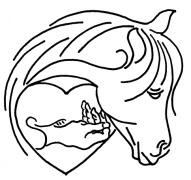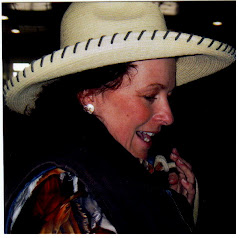
After attending the May Women’s Confident Leadership Camp many students of horsemanship on my yahoo chat group have been discussing the fact that getting out of their comfort zone at camp has changed their lives.
This morning I was reading the latest Savvy Times. There was an article in it about Katie Drake, Pat's Niece and Mary Ann Kennedy writing a new song. Here is a little from this article: It is very appropriate for a discussion on getting outside of your comfort zone.
Lyrics from the song:
"When you keep on doing what you've always done, you'll keep on getting what you've always gotten. The winds of change are runnin'through my veins, but this voice inside me, it keeps on talkin".
The article says: "That voice inside talking me out of change is none other than the familiar voice of FEAR! Afraid that taking the step of change in my life would lead to failure, I stay stuck in a perpetual cycle of procrastination and avoidance. The times when I've been able to take a step at a time, no matter how small, I've been able to break free from fear's stronghold and move toward my dreams."
How often do you get talked out of change by your fear and the feeling that the mountaintop dreams we have are unattainable?
Katie hopes, “this song encourages those who hear it to consider what they dream to do, and that it inspires them to start on the incredible journey, be it one small step at a time."
Are you ready for change?
I have been adding change to my horsemanship skills by going to more clinics myself this year. I am studying with Kirsten Nielsen, Karen Rolhf, and Bryan Neubert. I am learning how to help my horses stay in more correct posture and balance with better energy mixed with relaxation. It is turning into quite a lovely ride and more beautiful picture. Plus I can tell my horses are more eager to please because they are feeling better in their physical body as I work with them.
I am finding that quality movement in an exercise is more important than just going through the motions of the exercise. The changes in my horses are very significant. I am also discovering more about riding posture and how dramatically it effects not only the efficiency of movement of the horse but his behavioral issues also melt away as the rider improves posture, feel, timing, and balance.
So if you haven't been to one of my clinics in a while, I promise you are going to learn something new which will change both you and your horse for the better, if you apply the principles and skills.
Here is what Alison had to say about her camp experience:
For those of you who have attended a Women’s Confident Leadership Camp, I imagine you will agree with me when I say…WOW!! For those horsewomen out there who have not attended and are thinking of it…GO!! I knew this would be a tremendous experience of learning, bonding and growing with my horse Snap, but it exceeded my expectations. I had a horse who needed some “remedial education” with respect issues and in a short amount of time working with Sherry (and a time out!) Snap was changing for the better and so was I.
Sherry’s level of commitment to each student is amazing and the atmosphere of caring and support (during tears of frustration and elation) from Sherry and the other women is something I will carry with me for a long time. As the days pass, I am reflecting more and more on how this has changed my relationship with my horse and how I view fear in my life…this was life changing for me. The camp setting is terrific- peaceful and pampering…no worries about anything, a total escape. The food was wonderful and so was the hospitality from the Switzer’s. I have been able to take what I learned from camp and transfer my new skills to working with Snap at home…what a blessing!!
I’ve had Snap for 3 years, I do feel like we’re starting over and the best is yet to come!! I’m mad at myself for not “moving closer, staying longer” a couple of times at camp as I know my confidence would have grown even more. Snap was fine, I was in a safe learning environment but my head was thinking negative thoughts from Snap’s previous behavior. I wasn’t living in the moment but now I know how to do that. I can still hardly stop thinking about camp and how much I enjoyed it, even the rough spots because I was learning something…what an experience!!
Cindy’s thoughts on the comfort zone:
I think I've learned the most when I am OUT of my comfort zone. Just a little out, not way out! But you will get better at that as you do it more and more. Don't have regrets, hang on to those positive moments that moved you! Just going was a big step. Now it will only get better and better! It is hard to turn off the light bulbs of camp isn't it!? I honestly feel like I have floods of information swirling around my little head, and as time goes on, more and more soaks in. Especially when the fear is gone.
Lois talks about her camp experience:
I think it was a lot easier to push out of my comfort zone with all the support and encouragement we had at camp. I also learned so much as well as found I was making things a lot harder for myself. I am definitely thinking more now and am more aware of the responses I am looking for.
Everyone was sooooo right. What an experience and you had better believe I will be telling everyone about it. Very much worth driving 7 hours. I learned so much and really saw what a great equine partner I have. Moose was like a giant sponge and was like, "OK what are we doing next"...Goes to show...where the issue is...me....
Anyway my biggest aha was to focus on when I work on doing something and I am not thinking about a spook or fear. Got some great things that we can work on at home and even went on a trail ride.
I do have to say Sherry is like the energizer bunny...she goes and goes and goes...she worked way harder than the rest of us and did it with a smile and let me help you. I feel honored to have had the chance to come to a camp and you can count on the fact that there will be another. I am hooked.
Question about clinic topics:
I had someone ask me what will be covered at the clinic this weekend, here is a brief overview. But it can change when the riders and horses show up, because I take people and horses from where they are. I don't try to put everyone into the same mold. Any behavior issues will be addressed as needed as well as rider confidence.
The clinic will have ground work in the morning, to help your horse relax and pay better attention to the handler, to syncronize with the handler while walking, trotting, stopping. The horse will be asked to find self-carraige on the circle with smooth efficient transitions which would be easy for the rider to ride. We will seek the kind of self-carriage that will empower the horse and make it easier to carry a rider, plus harmony and fluidity of movement will be a goal, as well as impulsion.
In the afternoon the riders will be instructed on getting and keeping their horses attention, executing a proper one-rein stop, and efficient mounting and dismounting. Better seat control where we help the horse stay straighter left to right and front to back again for staying power, relaxation even when using energy, and better self-carraige. Directing and redirecting the horse (left/right and forward/backward) will also be evaluated.
If you have any further questions, don't be afraid to call, it is FREE to ask questions.
Happy Trails,
Sherry Jarvis
"Horsemen share knowledge. Showmen hide it in a corner and go home." -- AQHA Judge Dale Livingston













